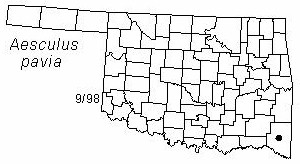Shrub to 2 m (6 ft) tall. Twigs thick, red-brown, with large triangular leaf scars. Leaves opposite, palmately compound, with long thin leafstalks. Leaflets 5, almost sessile, narrowly elliptical, acuminate, unevenly serrate, 6-15 cm (2.5-6 in) long and 3-6 cm (1.2-2 in) wide, shiny yellow-green above, paler and usually hairy below. Flowers numerous in upright branched clusters 10-15 cm (4-6 in) long at ends of leafy branches, bright red, somewhat bell-shaped, 13-19 mm (0.5-0.8 in) long, blooming in late Spring after the leaves appear. Fruits rounded capsules about 3 cm (1.2 in), smooth, light brown, maturing in Fall. Seeds 1-3 per fruit, large, hard, shiny, dark brown or black with a large paler basal spot.
Distribution: Coastal Plain, from North Carolina to Texas
Habitat: Usually in wet floodplain forests.
NWI status: FAC-
Comment: All parts of the plant are considered poisonous. It is sometimes cultivated as an ornamental shrub and the seeds are sometimes carried as good-luck charms. Aesculus is an old European name for some mast-bearing tree; pavia honors the Dutch botanist Peter Paaw.
Distribution in Oklahoma: 
BACK
NEXT
RETURN TO INDEX
Last update: 9/7/99
 Go to Oklahoma Biological Survey Home Page
Go to Oklahoma Biological Survey Home Page
 Disclaimer
Disclaimer